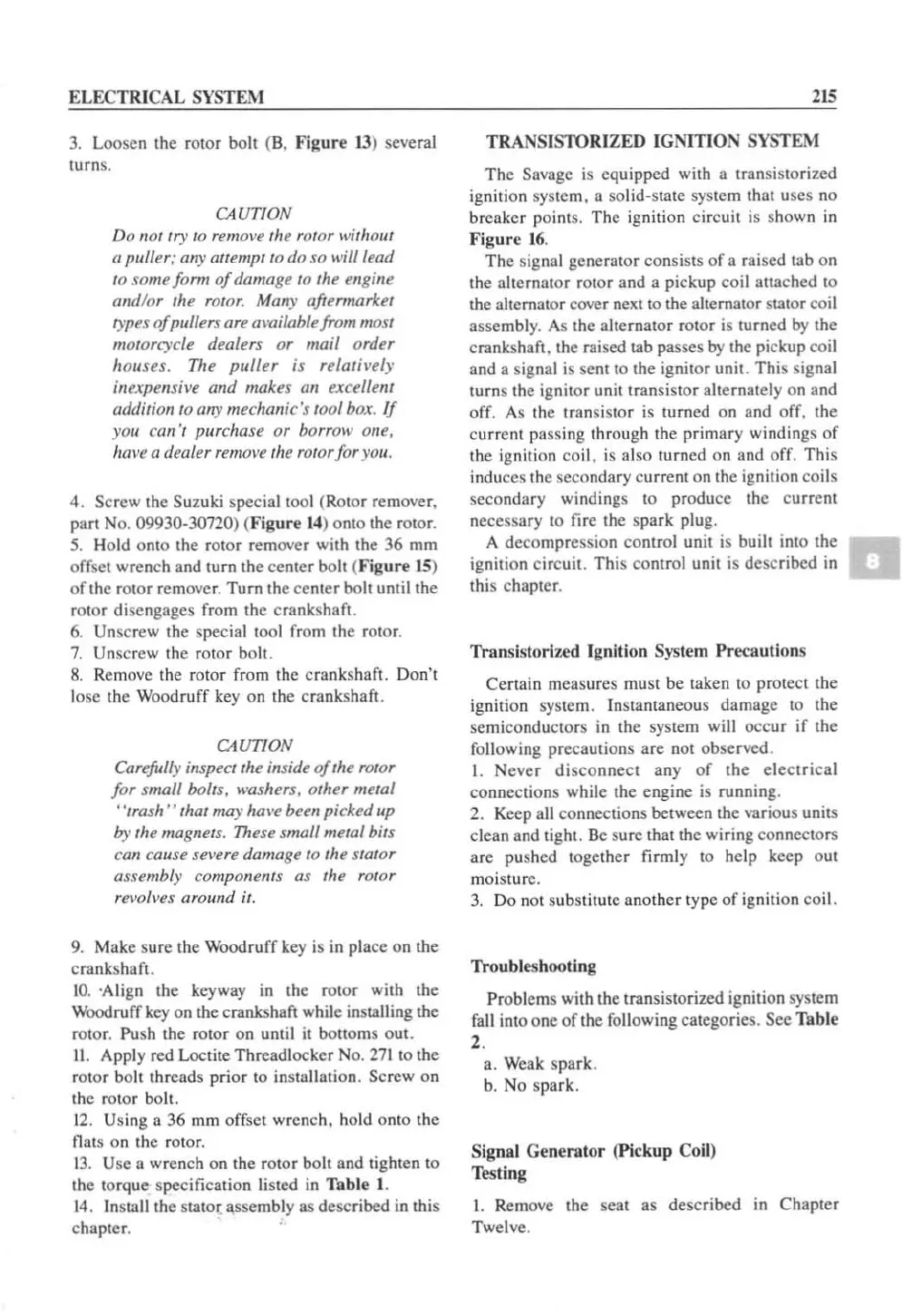ELECTRICAL
SYSTEM
3.
Loosen the rotor bolt (8. Figure
13
) several
turn
s.
CAUTION
Do
nOllry
to
remO\'e
,lie rotor wilholll
a puller;
any al/emp'
to
do so will lead
to
some form
of
damage to the engine
andlor the rotor. Many aftermarket
types
of
pullers are ami/able from most
motorcycle dealers or mail order
hOllses. The
puller
is relatively
if/apensil
'
t!
and makes
an
exctJlent
addition 10 any mechanic's tool box.
If
)'0
/1
c
an
" purchase
or
borrow
one,
have a (lealer
rem
ove
tlt
e rotor for YOII.
4. Screw the Suzuki special tool (Rotor remover,
pari No. 09930-30720) (
Figur
e
14
) onlo the rotor.
5.
Hold
ontO
the rotor remover with the 36
mm
offsct wrench and turn the center bolt (
Figure
15
)
of
the rOlor remover. Turn the center bo
lt
until the
rotor disengages from
the
crankshaft.
6.
Unscrew the special tool from the rotor.
7.
Unscrew the rotor bolt.
8.
Rem
ove the rotor from the crankshaft. Don't
lose the Woo
druff
ke
y on the crankshafl.
CAUTION
Carefully inspect the inside
of/he
rotor
for
small boils, washers, other metal
"trash" that
may ha\
'e
been picked up
by
the magnets. These small metal bits
can cause se\'ere damage
10
the stat
or
assembly components
as
the
ro
t
or
revolves around it.
9.
Make sure the Woodruff
key
is
in
place on the
crankshaft.
10.
'A
li
gn the keyway in the rotor with the
WoodruITk
ey
on
the crankshaft while installing the
rotor.
Pu
sh the rotor on until it bottoms
OUt.
II. Apply red Loctite Threadlocker
No.
271
to
the
rot
or
bolt threads prior
to
in
stallation. Screw on
the rotor bolt.
1
2.
Using a
36
mm offset wrench. hold onto the
nats on the rotor.
1
3.
Use a wrench on the rotor bolt and tighten
to
the torque specification listed
in
Table
I.
14.
In
stall
th
e stator assembly
as
described
in
this
chapter.
215
TRANSISTORIZED
IGNITION
SYSTEM
The Savage
is
equipped with a transistorized
i
gn
ition system. a solid·state system that uses
no
breaker points. The ignition circuit is sho
wn
in
Figure
16
.
The signal generator consists
of
a
ra
ised tab on
the alternator rotor and a pickup coil attached to
the alternator cover next to the alternator stator coil
assembl
y.
As the a
lt
ernator rotor is turned
by
the
crankshaft.
th
e raised tab passes by the pickup coil
and a signal is sent to the ignitor unit. This signal
tu
rn
s the ignitor unit transistor alternately on and
ofr.
As
the transistor
is
turn
ed
on and off. the
curre
nt
passi
ng
through the primary windings of
th
e
ig
n
it
ion coil. is also turned on and o
ff.
This
induces the secondary curre
nt
on the ignition coils
secondary windings
to
produce the current
necessary to
fi
re the spa
rk
plug.
A decompression control unit
is
built into the
ignition circuit. This control unit is described
in
this chapler.
Tran
sistori7.ed Ignition System Precautions
Certain measures must be taken
to
protect the
ignition
syS
tem. Instantaneous damage
to
the
semiconductors
in
the
sys
tem will occur if the
fo
ll
owing precautions are not observed.
1.
Never disconnect any
of
the electrical
connections while the e
ng
ine is running.
2. Keep a
ll
co
nn
ections between the
va
ri
ous units
clean and tight.
Be
su
re that the wiring connectors
are pushed together firmly
to
he
lp keep out
moi
st
ur
e.
3.
Do not substit
ut
e another type
of
igni
ti
on coil.
Troubleshooting
Problems with the transistorized ignition system
fall
i
nt
o one
of
the following categories. See Table
2.
a.
Weak
spark.
b. No spark.
Signal Generat
or
(Pickup Coil)
Testing
I. Remove the seat
as
described
in
Chapler
Twelve.

